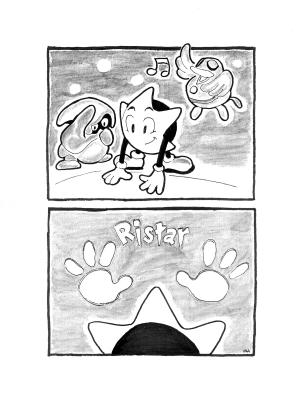Feelstar
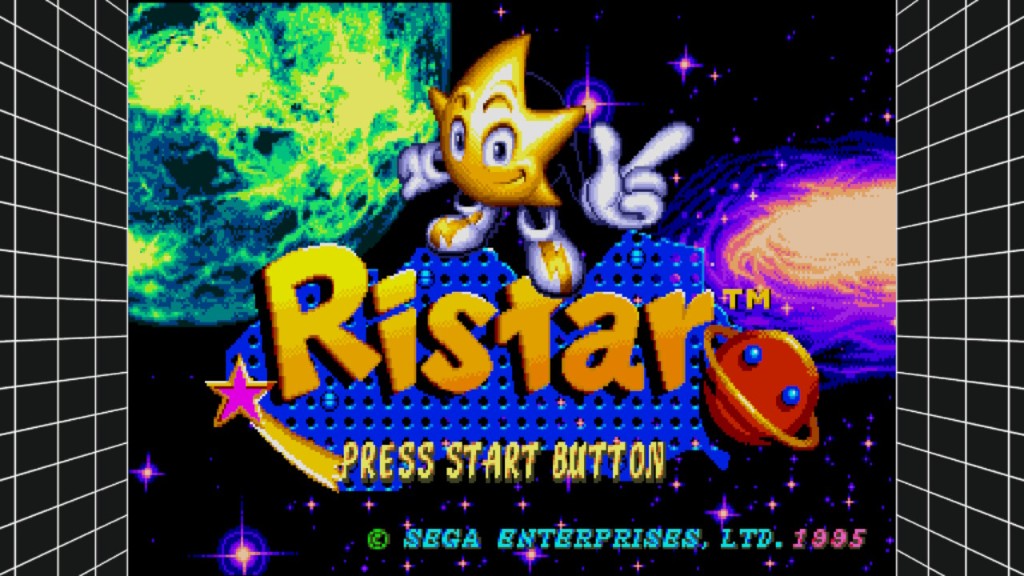
I’m not sure why this work is called Ristar. In the beginning it had another name, Feel, totally tied in its meaning to the goal whereof it was born: a 2D platformer videogame where the environment was felt, more than ever, and it wasn’t based solely in an architecture built around an avatar’s abilities. But that’s a thing that is a groundbreaking effort per se, because developing a complex mechanical system that has to be not only pleasing to the player, but to be expressive naturally, is tough. So, what does one have to do to go beyond? Ristar is the story of an original idea to create a new path. Nowadays, a long-forgotten story, but the path maybe not so much.
The microgame saga WarioWare knows this effect —feeling— really well, through a constant celebration of moments that keeps on adding with the goal of reaching a mental epiphany, result of non-stopped concentration and precise movements that you’ve shown off. But, in a certain sense, there’s not much of personal expression here. Ristar may be one of the last representations, along with Nintendo’s Yoshi’s Island from the same year, 1995, of a game of this kind (a 2D platformer) coming from a big company as an interactive environment for players. Even if the present denies this thanks to the indie scene, big companies started to either closing this way and rather delegate it to portable devices, with less relevant videogames compared to the ones of the home console/PCs counterpart, or simply becoming much less experimental (New Super Mario Bros., portable), with rare exceptions (Kirby and the Amazing Mirror, idem, the elusive Megaman & Bass for the Super Famicom in 1998, or PS2’s Klonoa 2, which is based on world building).
When I play Ristar, do you know what I precisely perceive? Arguments. Disagreements, quarrels. A hard but constant effort to make this star’s odyssey meaningful. There’s a decisive factor in this, and that’s the directions. Think about it this way: What is the direction Super Mario Bros. (NES) is based on? Right. Left tends to be nonexistent, especially if gets disappearing at your step. This feature is called “ratchet scrolling”. It’s not a kind of design that I’ve seen particularly imitated, much less in videogame hits, but what SMB’s case achieves is building a world around not only the jump, but the right direction too. Even beginning from a simple foundation like that, SMB finds itself with its own hardships starting from those ground points for constructing its path and having sense. It’s the main reason why broadening to two directions or more makes a great complication: it has to make sense going all those directions. To summarize: in Ristar, going back on your feet has to have some kind of sense so the left direction is relevant. And if you add Feel’s premise about feeling the environment, pieces just fall right into place.
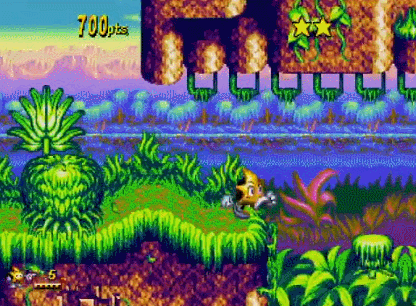
Feeling goes in two directions: feeling the good and the bad. And I’m not referring to highs and lows, no, but the variety of consequences that have been reached through Ristar’s mechanics and, in this special case, its gamefeel. Having Ristar also been born to differentiate itself from other platformers seen until then, the focus was pointed to the hands, not the feet. Consequently, the project was destined to be a hand-territory platformer, and not a feet-territory one. Original and subtly upstream. And fresh: it had to be like working with a new canvas, and that expressed and still expresses how experimental the bidimensional spaces still are for this media, before and now.
Ristar’s zen journey
Ristar’s universe is constituted by wonderful planets, harmonised with supreme music since the first world to the last, and it takes place in a planetary system that, however, is in danger. Nonetheless, even with this supposed urgency situation, our character will walk forward. There’s no hurry, really. To interact with the environment and the enemies, Ristar will execute his main ability of stretching both arms and grab everything he can catch to subdue it. Contrary to Mario or Sonic, Ristar is not gifted of primary properties that are manifested once you put him in motion. Especially Sonic. In the videogame that concerns us, the core is reduced to command, a clear action as an effect of pushing a button. It’s interesting to determine if the world built around you goes around this mechanic or not, because if you step in the first level and the first thing you do is pushing that button, you’d just stretch your arms and nothing would happen. Like trying to touch the moon, an action without effect. But, as I said before, there’s no hurry, not about this, because… Ristar walks. It’s the first useful and necessary action and the one that, in a natural way, set the pace. Players shouldn’t be in a hurry to make someone who likes walking run because, in essence, the world is made for your steps. And taking advantage of the fact that social distancing doesn’t exist in Ristar’s world (but the opposite), you can touch everything you want too to see the effect it causes. It’s Ristar’s flow.
The world is made to your steps, so, how are those worlds exactly? And how do Ristar’s hands enter into scene? As I said before and I wouldn’t tire myself of saying it, they’re wonderful, vibrant, from a tropical paradise to industrial, automatised planets. And the more are played, the more are comprehended, discovering what kind of secrets they hide. Your hands are your tool, your weapon, and they can interact with anything. Your legs, your curiosity in motion. But it’d be misguided to say that Ristar just walks, because more appropriately, he’s strolling: the world definitely responds better to one’s stroll rather than one’s simple walk. Our character strolls carefree wherever he goes. He’s also able to reach heights with his arm ability to find secrets or even elusive paths. Or the outstanding bonus stages.
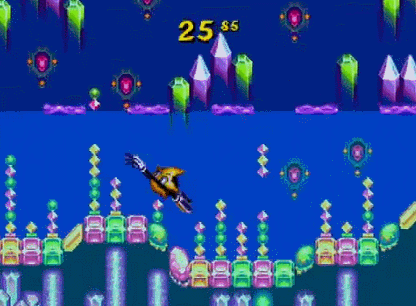
At first, I was given the impression that these special stages were the reason to explore the levels, to go back, left, down, up. But not really. The level design doesn’t have that kind of subservience, its secrets are not their purpose. Each planet is a place full of places, spaces where senses beyond touch get more relevance. And the stillness… If contemplation in videogames has a measuring rod is something I ignore, I’d rather there not be, but stopping Ristar’s motion is, curiously, avoiding him to be himself: he always does something different in each planet.
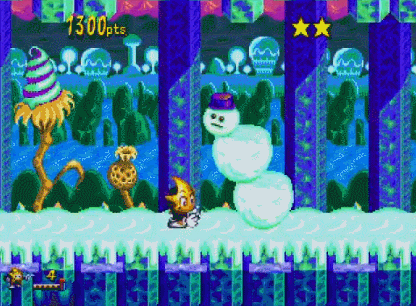
Action and lack of it conforms the feel that Feel always wanted. Advancing and going backwards too, and that’s why this is about a design that doesn’t believe in obstacles. If it was, why would someone want to go back if it’s not for challenging themselves again? Due to this, Ristar doesn’t defend that, but a here and now, specific spaces and the memory of those places. That’s why it aims for finding meaning in retracing your steps. Partially to find something, partially to keep feeling those spots. It’s great when the latter beats the former.
It is also enriching the fact that it feels different playing this game sequentially, from beginning to end, compared to selecting a level you choose. The appeal of the first option attempt goes like this:
- On one hand, the fact that it’s not possible to save your progress means that you need time for it. It’s like this because of its historical moment and aesthetic, but that doesn’t prevent it from experimenting it the way it was supposed to, and reserving a long time specially for it. A morning, an afternoon, a late night. A time where there’s only you and the videogame. This intimacy can be tied with any art work perfectly, so a specific time that is meant to play a game has the potential of being a really special one.
- On the other hand, it’s the effect that arises when you play this way. Step by step, while advancing, the acquiring knowledge through the game experience, the search of points, extra lives that maintains you more time and alive in your playthrough, all of that is tanning you for the end even if you’re not aware. It’s not something one could notice vividly selecting any level to focus only on that one, but the good part of that is that you have more time to dedicate yourself to one place.
Parenthesis: an anecdote
Given the last points I’d like to mention a special case: Planet Sonata, the music planet. In a videogame whose music is a blast, how to design a world that is music-themed? Surprisingly, making the opposite of anything I would’ve expected. Along with Planet Undertow, they are the worlds that experiment with linearity the most, being the difference that, to make this fact stand up, additionally an objective is given to you: to find a bunch of metronomes to give to sad singing birds because they can’t sing without them in order to go on (as a musician, I assure you this makes no logical sense, but let’s move on). This world shocked me the first time I saw it, because I ended up perceiving a message. Ristar, more than delighted with music, felt overwhelmed by it. He faked it superbly, but if my ears didn’t deceived me, it was like he was living the noisy and annoying side of music, not the harmonic one. And furthermore, adding to the fact that it is, was, lineal, it’s like it was implying that music isn’t free.
The second time I played this level, that impact was lost, but I consider that it was due to the fact that I selected this level directly, without a proper context. The third time was something new but at the same time, familiar. I decided to make a new playthrough, this time from beginning to end, with the goal of reaching the last challenge, Emperor Greedy, and overcome it… but I couldn’t do it, only grasp it. It was a dragged-on immersive session, so much, that anything that looked easy got me off guard, like attacking my fatigue. But a kind of special fatigue, an enjoyable one. Anyway, those moments of weakness were wake-up calls, which were no less in Planet Sonata, where I regained feelings from that first playthrough.
Greedy
He is the last challenge. It’s difficult, but not because it’s tough to beat him, but because how hard it can be to understand him. One could beat him without understanding anything, with cheap tricks, and afterwards getting a bitter taste and forget all about it. But something would be missing. To get to this point, you must have got through a bunch of defence lines. None as hostile as Greedy, but not that far from him. It has also been necessary to learn how the game mechanics and their details work. Some of them specific, others not that much. All of these are your weapons against the villain, and if you don’t employ them, a lot will depend on luck and not your ability and analysis. Something that no one wants. And there’s nothing better than overcoming menaces and attacks that once looked like something worse than impossible: unfair.
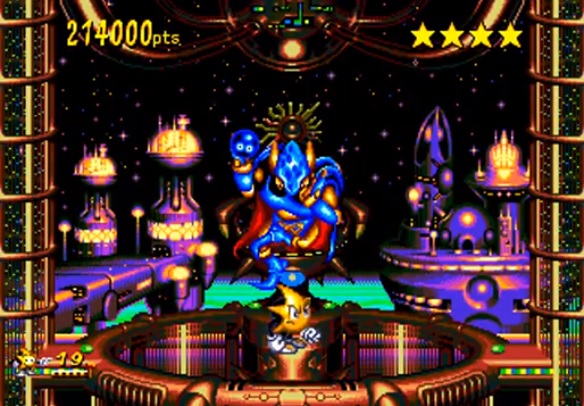
If Feel was about feeling the bad too, this without a doubt represents the toughest part of the path of conquering the end. Knowledge of a videogame increases its spirituality, and Greedy, Ristar’s final challenge is maybe the best case I’ve ever seen in a videogame of this genre. I’m referring to the spiritual outlook that, in search of its knowledge, that’s how your odyssey becomes, because all was always destined to this moment.
Ristar: anti-Sonic; Sonic, anti-Mario; Mario, anti-trends; Ristar, Ristar
I think I have overdone the title. It’s not like it speaks for itself.
I once heard that if someone wants to fight Star Wars, must not watch Star Wars. I’d say that in an artistic battle, that’d be the sportiest approach, because no one would parasite other’s ideas. Maybe some of you noticed it, but Ristar looks like Sonic visually, because both of them come from the same graphic engine. At the time this engine was developed with a series of specs and possibilities to antagonize, compete, but also to oppose Mario in every possible way. That’s why I find it fascinating that with this same engine was possible to do something more original and authentic that is Ristar, opposing the Hedgehog himself at the same time and, if that’s not enough, improving the final result in each one of its countermeasures.
- The first and most obvious one: to change running with walking. ¿Have you ever seen that cartoon gag where a character passes across something at full speed and is left blurred? We see it, but not the character. That’s exactly the same feeling that I have with Sonic stages, but I can’t see them, and even he can’t see them. Can’t even pass for hallucinogenic effect, because everything goes so much fast to percept it. If I were to compare, the original Super Mario Kart had a visual aesthetic of that sort much more effective, and overall, perceptible. Ristar’s response is so easy it hurts: Walking. Keep your own pace.
- Enemy existence that contributes, not subtract. I consider minions are leftovers in Sonic, or at least the way they were introduced wasn’t the best. They interpose his momentum more than supporting it, and also, concrete mechanics to approach them just lack, boiling down the situation to be quiet, waiting their moment of invulnerability and defeat them. Being fast, this action tends to depend on luck. In Ristar this situation is about 1) Angles, because your arms go in five directions not counting the ones below, and eight if you are going underwater; and 2) There’s a strategic approach to enemies to catch them successfully.
- Water is made for swimming, not for walking on the bottom. Ristar can show off because of its good water levels (surprise!), but also the fact that there’s no risk of drowning. To use speed here can be risky, but it’s a dose of risk that is worth it. Not to say that this is the situation where arms and legs are united in their utility.
- A nice left. Or more like a left side, or an opposite side. In addition to everything said previously about this trait, it’s a subtlety that, however, ends up being fundamental to determine how organic the environment you’re navigating is. When it’s about bidimensional spaces, these can be perceived as “lines” or “places”. What defines a line is its right, a right that it’s consumed constantly and characterised by obstacles to overcome. It’s like a theme resource heaped over itself (in the best of cases), which has designed obstacles taken from it to generate challenge, but its disposition doesn’t stimulate a concrete spatial conception for the player. The repetition of these spaces may provoke that the player assumes them by memorisation (and occasionally that’s how a space gets internalized), but it’s not the best result when someone aspires to give a habitability sensation in the environment he or she has designed. The “place” phenomenon, however, happens when looking back is worth it. And not only that, but going back too, to better understand the things. Yoshi’s Island, for example, has a nice left, while I particularly consider that Super Mario Bros. 3 does not, because the first two entries (counting The Lost Levels) are based on a concrete line design that SMB3 doesn’t apply/transform in a convincing way in its new opened levels: these ones, by having an improbable left, they doesn’t end up feeling like places vividly. And when they work better, the timekeeper doesn’t help. In Sonic’s case, other kind of problems happen: their levels are better places, but its left tends to suffer the problems I mentioned in the first point. Besides the fact that going back, due to the nature of the design, can’t be done running without stopping before, which implies that all momentum has to be recharged from zero, hoping that there are no issues that prevent it. It is taken for granted to comment on what I consider of Ristar and its ability to create places. It’s justified for them to be called planets, with the creativity that this suggests and keeps behind.
- And the last point is the “damage to die” and non-aesthetically elements. Sonic is vague in his fortitude, being the rings like a life preserver against the minimum damage dealt, which makes the option of running without them almost completely inadmissible. So Sonic, as an avatar, relies too much in other elements that make him work, like the bouncers too, which can be in any part of any world, being the perfect stage for them Casino Light Zone. But once again with Ristar’s case, his aesthetic feels more complete, because he doesn’t count with elements separated from his thematic ensembles. As for Ristar’s “death process”, it’s not something astoundingly original: your life points are stars, and when you lose them all, you go back to the checkpoint. It may be simple, but at least it gives you more opportunities than Sonic, plus you won’t find yourself in his state of perpetual haste and fear. Enemy hostility is such that it makes losing life serious, because remember: the journey is at all times preparing you for the end. And if you apply a dose of the previous point to this, it turns out that the enemy respawn allows any environment to remain as alive (and hostile) as when you left it.
Even though Ristar is settled over traditions, it’s his attitude towards them what makes the difference, starting with him and ending with the system that supports him. But, could be the case that he has overcome those traditions? After all, he’s only 10 years younger than the plumber’s famous game, but remarkably different thanks to his hands, the epicentre of his own vision. SMB didn’t start only establishing a new gaming paradigm as an answer to the gaming tendencies of that time: at the same time he innovated, he dug in the deepness of his new vision to explore its possibilities. That is why it remains so particular and worth studying today. Ristar and his hands are an integral part of this digging process. Consciously, it’s a great case of (auto)investigation about his genre.
The same way the aesthetic of 20th century’s classical music is a direct consequence of the transformation of western musical tradition ‘til that point in History, developing so new canvases to draw upon, Ristar is just one of the first steps to find new expression forms in this videogame medium. Perhaps distinctive enough to be an inspiration.
The end
I’ve reached the end by talking about Ristar’s own end, step by step in his development, talking about his ideas, the game itself, about how he tries to surpass himself regarding Sonic, about how it shocked me, every detail I’ve considered to mind, including his last moments as the sole attempt of suggest that everything is part of the same experience. It’s like a story, with a beginning, a development and an end. But all of this wouldn’t be anything if it wasn’t for your role as a player. Ristar’s hands are a virtual translation of your own hands. What the star feels is what you made him experiment by means of a series of commands, and by extension you are the one who feels: a curious player.
Ristar’s story goes on with you.
